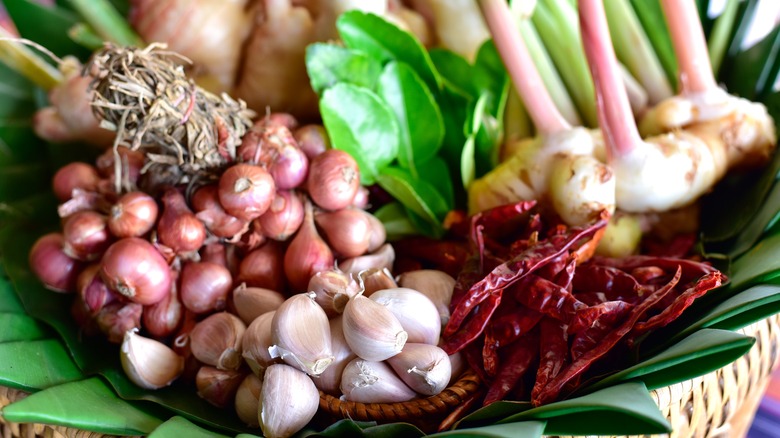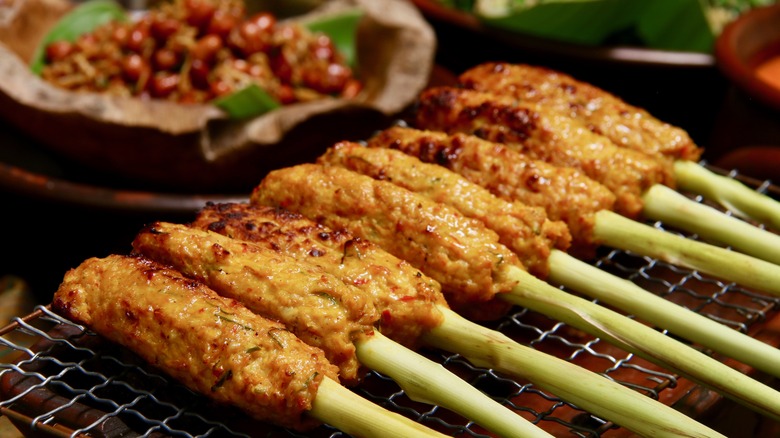What Is Balinese Base Genep And How Is It Used In Cooking?
Southeast Asia's largest country is home to a dizzying variety of cultures spread over 10,000 inhabited islands. It comes as no surprise that with such a diversity of people exists an extensive range of regional cuisines. Such applies to the vacation hotspot island of Bali, which boasts an abundance of culinary offerings. Home to an abundance of herbs, spices, and vegetables, the island's aromatics are most often employed through spice pastes.
None are more iconic than base genep, which translates to "complete spice." Many consider this paste the essential flavoring for Balinese cuisine as it blends together more than a dozen ingredients and provides the characteristic flavor for many classic dishes. While not commonly premade and found in Asian markets, you can easily find the ingredients needed there to prepare it at home. Akin to a curry paste or sambal, there may be many components needed for its creation, but few flavors are quite like it.
History of base genep
This aromatic spice blend has been a component of Balinese cuisine for nearly 2,000 years. Intertwined with spirituality, it's believed that base genep stemmed from the Pandawas and Drupadi goddess, a prominent figure in Hindu beliefs. A recipe for the blend is also linked to a historic manuscript called Dharma Caruban, which chronicles the food preparation for royalty. In alignment with Bali's Hindu influences, anthropologists believe the spice blend spread from techniques originating in India.
Base genep's components and preparation convey Bali's cultural influences and spiritual beliefs. Each aromatic base represents a region and associated God: Galangal represents Lord Brahma from the South, turmeric is God Mahadewa from the West, ginger is Lord Vishnu from the North, and kencur (a variety of ginger) represents Dewa Iswara from the East. Further tradition is involved when measuring the spices, with each root vegetable added proportionately to the fingers on the hand. Most components have likely remained the same for centuries, except for pepper, nutmeg, and clove. These spices are not native to Bali, signifying they're later additions.
Base genep is made with root vegetables and spices
Base genep comprises an extensive range of ingredients. The blend starts with aromatic root vegetables — turmeric, galangal, lesser galangal, ginger, garlic, shallots, and lemongrass. The components are left with the skin on for extra flavor and pulverized into pieces alongside chilies. A spice blend consisting of coriander, nutmeg, peppercorns, and candlenuts is also assembled in parallel. Coconut oil is the oil base of choice, with shrimp paste, sugar, salt, and salam leaves — an Indonesian variant of the bay leaf.
Ingredient deviations exist; Balinese chefs craft their renditions with unique spice blends and heat levels. And while the array of flavorings may seem daunting, the paste's intensely aromatic nature is due to the variety of components, so don't skimp out on ingredients — especially the base root vegetables. Ginger, turmeric, galangal, and kencur are cornerstone additions. Of these components, kencur may be the trickiest aromatic to find, so replace it with ginger if sourcing proves difficult.
How to prepare base genep
Traditionally, base genep is only blended by hand. The denser aromatics are first chopped with heavy cleavers and then finished in a mortar and pestle alongside the softer vegetables. The dried spices are pounded in a separate vessel since they're added later in the cooking process. While hand-grinding the mixture does lend an extra-immersive feel, there's nothing wrong with combining all of the ingredients in a food processor for convenience.
The denser root vegetables mixture is simmered in the coconut oil first, for approximately 4 minutes. Next, the dried spices are mixed in, and the blend is simmered on low heat until golden brown and fragrant. It's then allowed to cool since base genep is consumed at room temperature.
Keep in mind that the efforts involved in concocting base genep don't need to be for one occasion. According to Cook Me Indonesian, the spice mix will last for a week in the fridge and a month in the freezer when packed into an airtight container. Plus, it can be used in a variety of dishes.
Dishes prepared with base genep
Base genep is a component for various Indonesian dishes, from everyday lunches to ceremonial preparations. A common starting point is ayam suwir, a dish that combines boiled shredded chicken meat with coconut milk and base genep for flavoring. The spice blend's remarkable usability is showcased by the dish — it simply needs to be mixed into a sauce to act as a vehicle for a dish. In such a serving method, base genep is used as a curry base for a broader range of uses, not just with chicken.
Another application is duck betutu, where an entire bird is coated in base genep before roasting for several hours. Traditionally, the aromatic spices are infused by tightly wrapping the duck in bark or banana leaves and heating it over a fire. However, this can easily be done over a grill. This method of concealing any off-putting flavors in the duck creates a richly aromatic, slow-cooked dish.
Base genep is also used to flavor Indonesian skewers called sate. A popular version includes sate lilit, which combines the spice mixture with ground shrimp and fish. Another delicious variety is made with ground chicken. For optimal flavor, load the mince mixture onto a lemongrass stalk and char grill to completion.
Unlike sambal or the Indonesian soy sauce, kecap manis, base genep is not a tableside condiment but a cooking base. In addition to the dishes noted above, it's also used as an integral component in sauces, soups, and even classic Indonesian salads.




